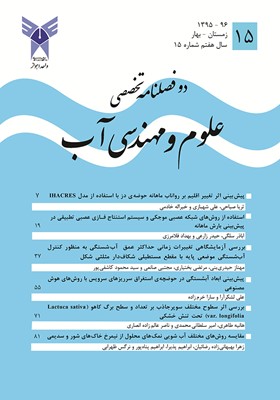Simulation of the climate change impact on monthly runoff of Dez watershed using IHACRES model
Subject Areas : Irrigation and Drainageثریا صیاحی 1 , علی شهبازی 2 , خیراله خادمی 3
1 - دانشجوی کارشناسی ارشد، دانشگاه صنعتی جندی شاپور دزفول، دزفول، ایران.
2 - دکتری منابع آب، سازمان آب و برق خوزستان.
3 - استادیار، دانشگاه صنعتی جندی شاپور دزفول، دزفول، ایران.
Keywords: Climate Change, تغییر اقلیم, Runoff simulation, IHACRES, APHRODITE, CMIP5, شبیه سازی آبدهی, APHRODITE و CIMIP5,
Abstract :
Identification and analysis of flow fluctuations in consequences of climate change is one of the most important factors in water resources management planning and this is vital especially in areas where large crowds are engaged in agriculture. Dez watershed, as an agricultural hub in the country, is one of areas that river flow fluctuations caused by climate change can affect a large population. In this study, by using gridded precipitation data APHRODITE and gridded temperature data set CHCN-CAMS, the IHACRES hydrological model was calibrated for the basin. Therefore, with introduction the temperature and precipitation under 2.6 Scenario of fifth report (CMIP5) to hydrologic model, flow fluctuations of watershed is simulation in future. result indicate that the temperature increase of 0.17-2 and precipitation changes of 3 to 75 percent in 2011-2035 period compared to the historical period (1983-2007). Runoff simulation result for future period showed that increases of 9.7 percent in long-term average annual runoff compared to the historical period.
Aich, V., Liersch, S., Vetter, T., Huang, S., Tecklenburg, J., Hoffmann, P., Koch, H., Fournet, S., Krysanova1, Krysanova, V., Müller, E. N. and Hattermann, F. F. (2014). Comparing impacts of climate change on streamflow in four large African river basins. Hydrology and Earth System Sciences, 18(4), 1305-1321.
Andermann, C., Bonnet, S. and Gloaguen, R. (2011). Evaluation of precipitation data sets along the Himalayan front. Geochemistry. Geophysics, Geosystems, 12(7): 1-16.
Chen, J., Brissette, F. P. and Leconte, R. (2011). Uncertainty of downscaling method in quantifying the impact of climate change on hydrology. Journal of Hydrology, 401(3–4):190–202.
Chen, J., Brissette, F. P. and Leconte, R. (2013). Assessing regression-based statistical approaches for downscaling precipitation over North America. Hydrology Process, 28(9):3482–3504.
Fan, Y. and Dool, H. V. D. (2008). A Global monthly land surface air temperature analysis for 1948-present. Journal Of Geophysical Research, VOL. 113, D01103.
Fu, G., Charles, S. P. and Chiew, F. H. S. (2007a). A two-parameter climate elasticity of streamflow index to assess climate change effects on annual streamflow. Water Resources Research, 43(11):W11419.
Fu, G., Charles, S. P., Viney, N. R., Chen, S. and Wu, J. Q. (2007b). Impacts of climate variability on stream-flow in the Yellow River. Hydrology Process, 21(25):3431–3439.
Fu, G., Charles, S. P., Chiew, F. H., Teng, J., Zheng, H., Frost, A. J., Liu, W. and Kirshner, S. (2013). Modelling runoff with statistically downscaled daily site, gridded and catchment rainfall series. Journal of Hydrology, 492:254–265.
Hao, X., Chen, Y., Xu, C. and Li, W. (2008). Impacts of climate change and human activities on the surface runoff in the Tarim River Basin over the last fifty years. Water Resources Management, 22(9): 1159–1171.
IPCC, 2013. Summary for policymakers. In: Stocker, T.F., Qin, D., Plattner, G.-K., Tignor, M., Allen, S.K., Boschung, J., Nauels, A., Xia, Y., Bex, V., Midgley, P.M. (2013). Climate Change: The Physical Science Basis, Contribution of Working Group I to the Fifth Assessment Report of the Intergovernmental Panel on Climate Change. Cambridge University Press, Cambridge, United Kingdom and New York, NY, USA.
.Jakeman A. J. and Hornberger, G.M. (1993). How much complexity Is warranted in a rainfall-runoff model?. Water resources research, 29(8): 2637-2649.
Kotsuki, S., Tanaka, K. and Watanabe, S. (2014). Projected hydrological changes and their consistency under future climate in the Chao Phraya River Basin using multi-model and multi-scenario of CMIP5 dataset. Hydrological Research Letters, 8(1), 27–32.
Liu, Z., Xu, Z., Charles, S. P., Fu, G. and Liu, L. (2011). Evaluation of two statistical downscaling models for daily precipitation over an arid basin in China. International Journal of Climatology, 31(13):2006–2020.
Ma, C., Sun, L., Liu, S., Shao, M. A., and Luo, Y. (2015). Impact of climate change on the streamflow in the glacierized chu river basin, central asia. Journal of Arid Land, 7(4), 501-513.
Ouyang, F., Zhu, Y., Fu, G., Lü, H., Zhang, A., Yu, Z. and Chen, X. (2015). Impacts of climate change under CMIP5 RCP scenarios on streamflow in the Huangnizhuang catchment. Stochastic environmental research and risk assessment, 29(7), 1781-1795.
Risbey, J. S. and Entekhabi, D. (1996). Observed Sacramento Basin streamflow response to precipitation and temperature changes and its relevance to climate impact studies. Journal of Hydrology, 184(3–4):209–223.
Tan, M. L., Ficklin, D. L., and Yusop, Z. (2014). Impacts and uncertainties of climate change on streamflow of the Johor River Basin, Malaysia using a CMIP5 General Circulation Model ensemble. Journal of Water and Climate Change, 5(4), 676-695.
Wilby, R. L., Hay, L. E. and Leavesley, G. H. (1999). A comparison of downscaled and raw GCM output: implications for climate change scenarios in the San Juan River basin. Colorado. Journal of Hydrology, 225(1–2):67–91.
Wilby, R., Charles, S., Zorita, E., Timbal, B., Whetton, P. and Mearns, L. (2004). Guidelines for use of climate scenarios developed from statistical downscaling methods. Supporting material of the Intergovernmental Panel on Climate Change (IPCC), prepared on behalf of Task Group on Data and Scenario Support for Impacts and Climate Analysis (TGICA).
Zhang, A., Zhang, C., Fu, G., Wang, B., Bao, Z. and Zheng, H. (2012). Assessments of impacts of climate change and human activities on runoff with SWAT for the Huifa River Basin. Northeast China, Water Resources Management, 26(8):2199–2217.

